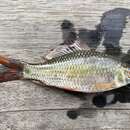Diagnostic Description
(
englanti
)
tarjonnut Fishbase
Distinguished from the other species of the genus in having 12-18 branched dorsal rays; 6-9 rows of spots along scale rows (not always distinct), and a large round blotch on the caudal peduncle (Ref. 27732). No black midlateral stripe; sometimes with a spot above a pectoral fin (Ref. 12693).
- lisenssi
- cc-by-nc
- tekijänoikeus
- FishBase
Migration
(
englanti
)
tarjonnut Fishbase
Potamodromous. Migrating within streams, migratory in rivers, e.g. Saliminus, Moxostoma, Labeo. Migrations should be cyclical and predictable and cover more than 100 km.
- lisenssi
- cc-by-nc
- tekijänoikeus
- FishBase
Morphology
(
englanti
)
tarjonnut Fishbase
Dorsal soft rays (total): 17 - 19; Analsoft rays: 8
- lisenssi
- cc-by-nc
- tekijänoikeus
- FishBase
Trophic Strategy
(
englanti
)
tarjonnut Fishbase
Omnivorous (Ref. 123180). Feeds on plants, zoobenthos, zooplankton and detritus (Ref. 13497). Recorded as having been or being farmed in rice fields (Ref. 119549).
- lisenssi
- cc-by-nc
- tekijänoikeus
- FishBase
Biology
(
englanti
)
tarjonnut Fishbase
Adults occur in all type of habitats, but usually associated with large streams with slow current and muddy to sandy substrate (Ref. 27732). They migrate from river to flooded areas during the onset of the flood season and returns to river habitats at the end of that period (Ref. 37770). Juveniles are usually seen first in August, they move back to permanent water as flooded lands dry up. Back in the rivers they are attached to brush piles, tree roots and other solid objects (Ref. 12693). Adults feed on roots of plants (Hydrilla verticillata), unicellular algae and some crustaceans. Most abundant fish in Nam Ngum reservoir where it is captured with large dip nets set on rafts. Good flesh but bony and used for lap pa or grilled (Ref. 6459). Marketed fresh or used to make prahoc (Ref. 12693).
- lisenssi
- cc-by-nc
- tekijänoikeus
- FishBase
Importance
(
englanti
)
tarjonnut Fishbase
fisheries: highly commercial; aquaculture: commercial; aquarium: public aquariums
- lisenssi
- cc-by-nc
- tekijänoikeus
- FishBase
Osteochilus vittatus
(
englanti
)
tarjonnut wikipedia EN
Osteochilus vittatus is a species of cyprinid fish from Southeast Asia.[2][3] Its common name is bonylip barb,[2]Hasselt's bony-lipped barb, hard-lipped barb, or silver sharkminnow.[1] It grows to 32 cm (13 in) SL.[2]
Distribution
The species is widely distributed in the Malay Peninsular and Indochina as well as southern China (Yunnan), Java, Sumatra, and Borneo. It occurs in the Salween, Mekong and Chao Phraya basins, as well as in many smaller drainages.[1][2]
Habitat
It inhabits a wide range of freshwater habitats: lowland marshlands, lakes, peat swamps, rivers, and hill streams.[1] It is usually associated with slow-flowing large streams with muddy to sandy rocky bottom.[4]
Diet
Adults feed on aquatic plants and particularly the roots of the plants (Hydrilla verticillata), unicellular algae and some crustaceans.[2] Young are reported to feed on detritus.

Osteochilus vittatus Bleeker.

Snout and lip of
Osteochilus vittatus
Utilization
Osteochilus vittatus is an important fishery species in the Mekong and Chao Phraya basins. It is occasionally present in aquarium trade.[1]
References

- lisenssi
- cc-by-sa-3.0
- tekijänoikeus
- Wikipedia authors and editors
Osteochilus vittatus: Brief Summary
(
englanti
)
tarjonnut wikipedia EN
Osteochilus vittatus is a species of cyprinid fish from Southeast Asia. Its common name is bonylip barb,Hasselt's bony-lipped barb, hard-lipped barb, or silver sharkminnow. It grows to 32 cm (13 in) SL.
- lisenssi
- cc-by-sa-3.0
- tekijänoikeus
- Wikipedia authors and editors

